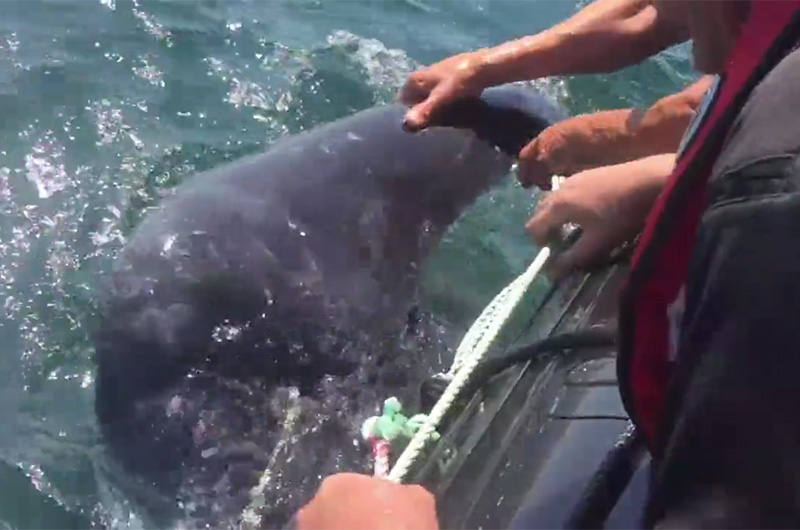It was a sunny Wednesday afternoon when Bret Stearns, director of the natural resources department for the Wampanoag Tribe of Gay Head (Aquinnah), got a call on his mobile phone. On the other end of the line was the Center for Coastal Studies in Provincetown, which had just received a call about a sea turtle in distress about a mile southwest of Menemsha.
Mr. Stearns grabbed one of his assistants, Tyler Moreis, and headed for the water. On the way, they passed Aquinnah harbormaster Brian (Chip) Vanderhoop. They turned around, caught up to Chip, and enlisted his help.
Rescuing sea turtles is a tricky business. Everything has to go right. On this day, the first thing that went right was Joe and Theresa Brossi spotting the distressed turtle and calling the U.S. Coast Guard to report its position.
“You see it choking a bit and panicking,” Mr. Brossi said. “You want to help it, but the first thing they tell you on the radio is don’t go near it.”
The second thing that went right was Mr. Brossi and his wife staying with the animal, making it relatively easy for the rescue team to find them.
When the rescue team arrived, they found a large leatherback turtle tangled in the line of a lobster pot, thrashing around trying to free itself. It is a scenario Mr. Stearn’s staff experiences two or three times each year, and they are well prepared. The tribe’s natural resources department receives training in sea mammal rescue from the Center for Coastal Studies.
“That ranges from turtles up to whales,” said Mr. Stearns. While he said he is not eager to jump into the business of disentangling whales, the training does provide valuable information, and the Center for Coastal Studies holds a federal license that allows them to train others and oversee rescues.
“It’s really safety oriented,” he said. “The technique for trying to unwrap, or if you do have to make cuts you practice different methods of trying to insure you’re going to get 100 per cent of [the entanglement] off.”
It turns out cutting a line entangling a turtle is about the last thing you want to do.
“If you cut the rope and it’s still around the neck and its 800 pounds and it swims away from you, you’re not going to get it again,” Mr. Stearns said. “You don’t want to waste all that time and effort by letting it not survive because you tried to be too quick about it.”
Though it may seem counter intuitive with a distressed animal thrashing about, sometimes patience is the biggest virtue.
“Sometimes you just have to wait it out,” Mr. Stearns said. “You might be there an hour, an hour and a half, until it gets tired enough to give you a shot.”
The turtle they rescued last month was estimated to be about 4 1/2 feet long, weighing 700 to 800 pounds. The line was wrapped around the animals pectoral fins and neck, with the lobster buoy complicating the whole thing.
The rescue team leaned out over the edge of a rigid bottom inflatable boat. Mr. Moreis managed to made a video of the rescue, while steadying the line connected to the submerged lobster pot.
In the video the leatherback thrashes violently at times, but at other times seems to relax and give the rescuers a precious few moments to work.
“This one was, call it, participatory,” Mr. Stearns said. “We got a hook on it, and we could hold on. We could hold on to the animal in a way that provided a little bit of slack. He was fatigued enough so that we could work with it, but not so fatigued that it would ultimately be its demise.”
Still, it was a dangerous situation. The rescue team concentrated on keeping themselves safe, well aware of the power of the animal.
“You don’t want to wrap your hand around anything,” he said. “If he starts to swim around, then that pulls tight on your hand, that crushes your hand. It’s amazing, they take one flipper, and they move [the boat]. He was dragging the boat sideways into the wind. That’s how powerful they are. Beautiful, but very, very powerful.”
The video shows Mr. Stearns and Mr. Vanderhoop working in tandem to sort out the tangle and unwrap it from the turtle’s flippers and neck.
“Work on your side for a second, take the slack,” Mr. Stearns tells Mr. Vanderhoop in the video. “I’m not going to be able to hold him.”
After several minutes of exhaustive work, they worked the line into position where one more maneuver would set the turtle free. They paused for a few seconds to make sure and the turtle seemed to cooperate. The last wrap slid off the turtle’s neck and Mr. Stearns gave the animal a quick pat on the head, while Mr. Vanderhoop gave it a pat on the back. Then the turtle swam powerfully away from the boat, seemingly little worse for wear.
Mr. Stearns thrust his arms in the air and cheered. On this day, everything went right.
“You love it when it works,” he said. “It doesn’t work every time. It’s a great feeling. You know that animal is going to go on its way, and that’s special. It’s not something we get to do every day. That’s why you train. That’s why you keep your equipment ready. They’re beautiful animals.”
Mr. Stearns cautions that no one should try to rescue a sea mammal in distress unless they have the proper training and a license. Handling the powerful animals can be dangerous, both to the animal and the would-be rescuers.
The proper thing to do, he says, is call the Center for Coastal Studies rescue hotline at 800-900-3622. Calls for help can also be relayed by the U.S. Coast Guard if contacted by VHF marine radio.
Then everything has to go right.








Comments (3)
Comments
Comment policy »